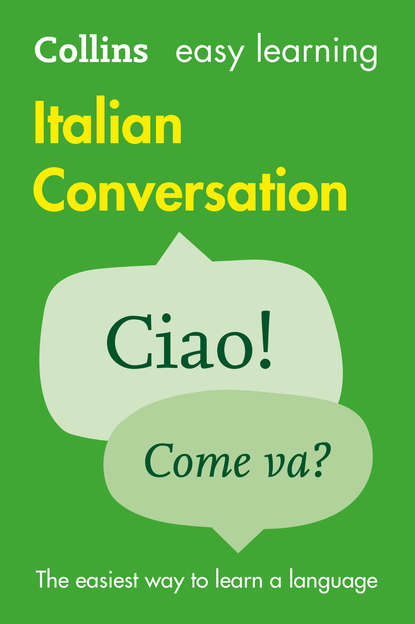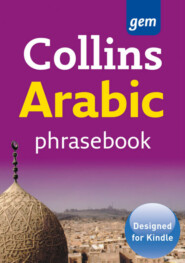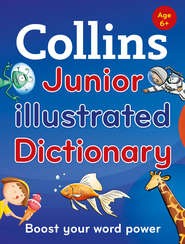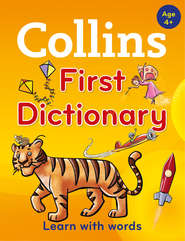По всем вопросам обращайтесь на: info@litportal.ru
(©) 2003-2025.
✖
Easy Learning Italian Conversation
Автор
Год написания книги
2019
Настройки чтения
Размер шрифта
Высота строк
Поля
Verb tenses (#litres_trial_promo)
Verb tables (#litres_trial_promo)
Parlare: to speak (#litres_trial_promo)
Credere: to believe (#litres_trial_promo)
Dormire: to sleep (#litres_trial_promo)
Andare: to go (#litres_trial_promo)
Avere: to have (#litres_trial_promo)
Dare: to give (#litres_trial_promo)
Dovere: to have to (#litres_trial_promo)
Essere: to be (#litres_trial_promo)
Fare: to do, to make (#litres_trial_promo)
Potere: to be able (#litres_trial_promo)
Volere: to want (#litres_trial_promo)
Vocabulary builder (#litres_trial_promo)
About the publisher (#litres_trial_promo)
Introduction (#ulink_ffc3da66-5e00-5ecb-b0b7-047f133683fe)
What is it? (#ulink_e5a1494d-2c5c-555a-8762-5ebe6e6f5666)
Collins Easy Learning Italian Conversation is a book for learners of Italian of all ages. It will increase your confidence in holding a conversation in Italian, whether you are just starting to learn Italian, studying at school or at an evening class, or brushing up your language skills. You may be going on holiday or planning to go travelling in Italy, go there on business, or live there. Whatever your situation, you’ll want to be able to communicate effectively and naturally in Italian.
Why do you need it? (#ulink_a41fbfe7-271b-531e-87b2-8593fbd6710c)
Becoming proficient in a foreign language means being able to use and understand a number of different aspects – vocabulary, grammar, pronunciation, and so on. However, it takes a while to be able to put all these elements together and be sure that what you are saying sounds like natural Italian. The Easy Learning Italian Conversation has been carefully designed to bring these aspects together and give you language structures which you can use in conversation with confidence, knowing that you will be speaking Italian as spoken by Italian speakers.
How is it structured? (#ulink_cad3e519-f9a5-5bbd-bc3b-4d64cc05299d)
Collins Easy Learning Italian Conversation is made up of 12 units, each illustrating the language used in a particular situation, followed by a summary which brings together the key language covered throughout the units. You’ll also find the One-stop phrase shop (#litres_trial_promo) – a unit which contains all the important expressions and turns of phrase that help you to sound more natural in Italian. A short grammar and verbs supplement gives you additional language support, ensuring that you have everything at your fingertips. Finally, the English-Italian glossary covers the most important vocabulary you may need to personalize your conversation.
How does it work? (#ulink_ce00ed94-019d-5903-a13a-bbfacf497c31)
Language allows us to express ourselves and interact with others. In any given situation, we perform different language tasks, such as asking for information, agreeing and disagreeing, complaining, making suggestions and so forth. To do this, we use linguistic structures (How…?, When…?, Could I…?, I’d like… and so on) which can be used in a variety of contexts. Each unit in Collins Easy Learning Italian Conversation gives you all the phrases you might need in a given situation, grouped by structure. English headings help you navigate through the structures to enable you to find what you want quickly and easily. Throughout the units, there are also tips headed Buono a sapersi! which highlight important differences in the way English and Italian work.
To help you with the different forms of the word ‘you’ in Italian, English translations are given as You = polite form, you = informal form, you = plural form. Italic letters in Italian words show where stress does not follow the usual rules.
A conversation, by definition, is a two-way process. It is as important to understand what is being said to you as it is to be able to respond. At the end of each unit, there is a section headed Listen out for. Each of these sections gives you a variety of the most typical phrases which you might hear in a given situation. Becoming familiar with these will allow you to have a successful conversation with a Italian speaker. For further help with pronunciation, a free download with all the important structures recorded is available on www.collins.co.uk/easylearningresources.
Communicating effectively in Italian isn’t just about linguistic competence – it’s also about cultural knowledge. For you to feel confident in Italy, it is also useful to know more about Italian culture and lifestyle. At the end of each unit, the Lifestyle Tips will give you the information you need to gain a deeper insight into the language, the country and its people.
Why choose Collins Easy Learning Italian Conversation? (#ulink_1a753fbf-2a06-5ded-be27-573eaf9d3a41)
• easy to use all the key language structures you need to give you the confidence to hold a conversation in natural Italian
• easy to read a clear, modern layout which allows you to find what you need quickly and easily
• easy to understand the language you may hear from Italian speakers in a given situation
• easy to speak free audio download available on www.collins.co.uk/easylearningresources
The Collins Easy Learning range (#ulink_0437892b-2a4d-53cc-b250-64d2fbd6d161)
The Collins Easy Learning Italian Conversation is part of the best-selling Collins Easy Learning range, which includes the highly acclaimed Collins Easy Learning Italian Dictionary. Collins Easy Learning Italian Grammar and Collins Easy Learning Italian Verbs support you with all your grammatical needs. The Collins Easy Learning series is the ideal language reference range to help you learn Italian.
Italian pronunciation (#ulink_1a4ef9ea-c475-5ce6-8165-9412c9c45751)
Italian pronunciation is not very difficult. Words are written pretty much as they sound, so when you see a word written down you can generally pronounce it with no problem, and when you hear a new word you know immediately how to spell it. There are no sounds in Italian that are very different from English. Below we give some tips to help you speak natural-sounding Italian.
Italian vowels (#ulink_aafc335e-5dfb-5df6-8ab6-0079236d90cd)
In English, vowels we don’t emphasize often sound like “uh”, so the e in mother and the a in central sound just the same. Sometimes vowels don’t get pronounced at all, as is the case with the first e in interesting. In Italian this never happens. Italian vowels are always clearly pronounced.
Italian vowels are generally pronounced as follows:
Italian consonants (#ulink_edb87d17-bece-523f-878f-778b7e67aea0)
Most Italian consonants are pronounced the same as English ones, except that double consonants are two distinct sounds, so that the tt in tutto is pronounced as in hat trick and not as in fitted.
The following are Italian consonants that differ from English:
Which syllable to emphasize (#ulink_220e4fbf-486b-561a-af61-75b5127c4ece)
To make your Italian sound more fluent and natural you need to stress the right syllable. Here are some guidelines:
• Two-syllable words always stress the first syllable, unless the final vowel has an accent:
• Words with three or more syllables generally have the stress on the next to the last syllable:
• If a word has an accent on the final vowel, it is stressed on the final syllable.
Words of this type include many nouns that end in –ty in English
• Two future tense forms always have an accent (I and he/she/it/You):
• Some words have the stress on a syllable which is not the last, or the next to the last. In this book we use italics to show when an unexpected syllable is stressed, to help you learn the correct pronunciation.











